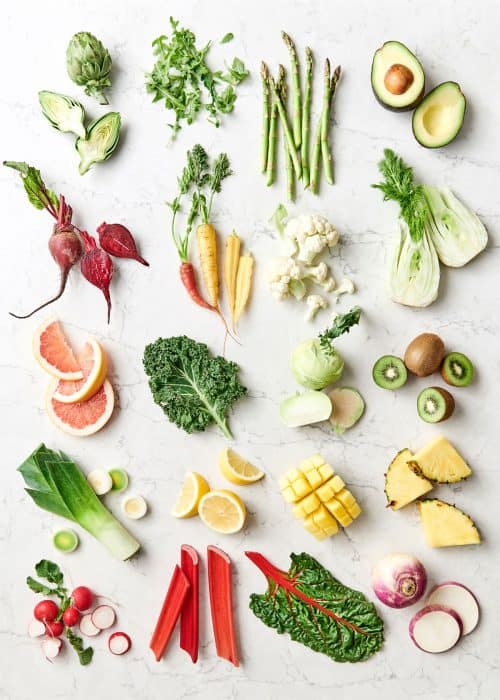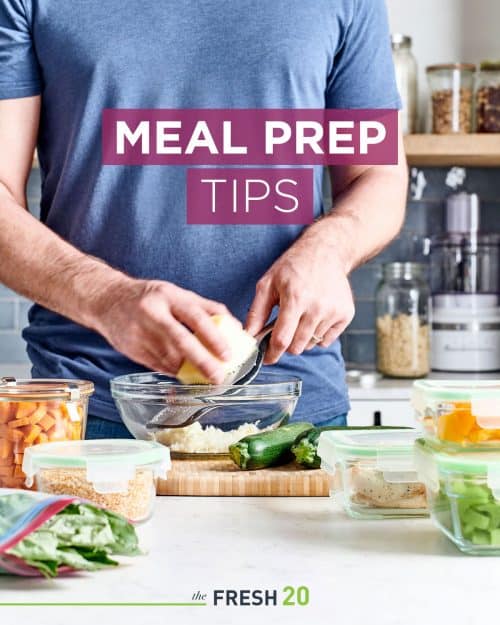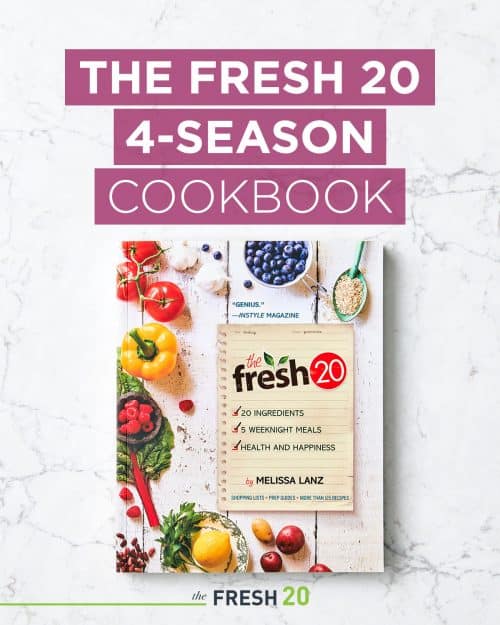Vibrant Spring Produce Perfect for your Meal Planning Needs
Don’t you love it when spring produce come out to play? Of course we do! We’re all giddy when the spring fruits and vegetables are in season. Time to go beyond the winter squash and potatoes and get fresh with green ingredients. Spring vegetables are tangy, spicy and sour which makes for some really interesting cooking.

ARTICHOKE
The globe artichoke, also known as French artichoke, is a prickly vegetable made of the flower bud of a thistle plant. They grow on stalks, much like a sunflower. Most stalks have a large bud on top and smaller (baby artichoke) buds underneath.
They are delicious when steamed, boiled, microwaved and even grilled, and are commonly served with creamy dips and sauces. When boiled or steamed, artichokes have a soft, buttery sweetness. To help prevent artichokes from darkening during preparation or cooking, use stainless steel utensils and pans.
Artichokes are available year round, but they peak between March and May.
BUYING: Look for buds that are heavy for their size with a tight leaf formation. The leaves should squeak when you press them together, but avoid buds that look too dry. As for color, a browning isn’t good, but a slight discoloration caused by frost is okay. Small artichokes are often more tender; rounder bulbs have larger hearts.
STORING: Keep artichokes unwashed in the fridge for up to 4 days. Wash just before you cook them. Covered and refrigerated, cooked artichokes will last up to 3 days.
ARUGULA
Arugula (also known as rocket) is a pungent green leaf plant popular in Italian cooking. It has an earthy, peppery taste with mustard undertones. Mature arugula leaves can be somewhat bitter. Arugula is grown year round but it’s peak is in the summer months.
Arugula is high in antioxidants, iron and vitamin A and has many health benefits contributing to weight loss, vibrant skin and boosting the immune system.
Typically, arugula is prepared as a salad with a citrus based dressing but it also works well as an addition to pasta and sandwiches.
Look for arugula with fresh bright color and a clean, fresh scent. Avoid yellow spots and wilted leaves. To keep fresh, refrigerate in a plastic bag wrapped in paper towels.
ASPARAGUS
AVOCADO
Avocados are a stone fruit with a creamy texture. Hass Avocados are the most popular variety avocado in the US. Their distinctive skin turns from green to purplish-black when ripe. They have a pale green flesh with a creamy texture and nutty flavor.
Avocados are a naturally nutrient-dense food and contain nearly 20 vitamins and minerals. Choose soft, ripe fruit and avoid bruising and sunken spots. Try our Smoked Salmon Avocado Toast.
BEETS
Beetroots, commonly known as beets, are a popular root vegetable used in many cuisines around the world. Beets are loaded with vitamins and minerals and low in calories and fat.
The most common beet has deep red roots with purple red tops and large green leaves. Both the root and the greens can be eaten. Beats are delicious roasted.
Beets store nicely in the fridge for up to two weeks depending on humidity of fridge. Try our Red Berry Smoothie with beets.
STOP Wasting $1500!
Forget grocery regret. Get a plan.
CARROTS
Store in the refrigerator’s vegetable bin or after opening, in a plastic bag for up to 14 days. Try our anti-inflammatory Orange Carrot Ginger Turmeric Juice.
CAULIFLOWER
If you haven’t tried roasting cauliflower you will be delighted with the rich, nutty flavor that can be developed with just a bit of oil and a hot oven. Low in calories with tons of vitamin c, fiber and protein, cauliflower is a nutritional powerhouse! While we mostly see it in white, cauliflower comes in a variety of beautiful colors such as green, orange, and even purple. Preparation is easy, just remove the outer leaves and any discolored spots then trim the florets off where they meet the stalks.
For our Paleo members who are forgoing grains, we often substitute cauliflower rice. However, even if your family does enjoy pasta now and again, substituting cauliflower rice is a great, lower carb way to add more vegetables to your meals. To make cauliflower rice simply combine 2 heads of roughly chopped cauliflower in a food processor with 1 yellow or white onion (roughly chopped), a garlic clove, and a pinch of salt. Pulse until the mixture resembles rice. In a large skillet, heat 1 Tablespoon olive oil. Add the cauliflower rice mixture and sauté for 5 minutes until it is lightly brown. Store in the refrigerator until needed – it reheats well. You can substitute it in equal amounts for rice, quinoa, or most any grain. Leaves and any discolored spots then trim the florets off where they meet the stalks. Try our paleo Cauliflower Hashbrowns recipe.
FENNEL
Known for its mild licorice flavor, fennel is a popular ingredient in Mediterranean cuisine. It is high in fiber and potassium and one of the few vegetables where ALL parts of the plant can be eaten; bulb, stalk, and fronds. Choose pale green, firm heavy bulbs with green feathery fronds and no blemishes on the bulb end. Bigger isn’t better here – choose bulbs that aren’t huge – under ½ pound insures they are at peak flavor and aren’t overripe. To prepare the bulb for cooking, cut off the celery-like stems and the root end of the bulb. Cut the bulb in half lengthwise and slice according to recipe directions. The stems are great for flavoring stock, and the feather leaves make a great garnish, so don’t discard them!
GRAPEFRUIT
Long touted as a remedy for skin, digestive, joint, and kidney disorders, grapefruit has been a popular subject in health and nutrition lore since its introduction in the U.S. in the 1800s. While many of its health claims remain open to debate, one thing is certain – it is a nutrition and taste powerhouse.
Eating half of a grapefruit per day satisfies more than half your vitamin C needs and a quarter of your vitamin A needs. Go beyond the half grapefruit for breakfast and add segments to smoothies and salads or serve grapefruit for a light summer dessert – either plain, grilled, or drizzled with honey. Some good dinner table trivia: Do you know why they are called ‘grape’ fruit? They grow in clusters on trees, and in their unripened form they look like clusters of grapes. IMPORTANT NOTE: Grapefruit can interact with certain medications causing serious health effects – be sure to check with your physician to see if there is a potential interaction.
KALE
Kale is considered a super food and is a great addition to any diet. It is a form of cabbage; green in color, with a variety of leaves. Kale leaves can be curly or flat.
Kale is considered to be one of the most highly nutritious vegetables, with powerful antioxidant and anti-inflammatory properties. Look for Kale with firm, deeply colored leaves and moist stems. Kale should be wrapped in a damp paper towel then placed in a plastic bag and stored in the refrigerator. Try our refreshing Kale Grape Mint Smoothie.
KOHLRABI
Kohlrabi is in the same family of vegetables with cabbage, kale, cauliflower and broccoli. It has a thick skin that can range from pale green to purplish, though the inside is always a very pale yellow. The leaves are also edible and can be used in soups or stir-frys.
Even though both the leaves and stems are edible, Kohlrabi is sometimes sold without the tops. The Kohlrabi will keep up to a week or more, and the leaves for several days. Kohlrabi can be enjoyed raw or grated, cubed or thinly sliced, then boiled or steamed.
KIWI
Kiwis have a juicy, slightly tart flavor reminiscent of melon and fresh berries. Kiwis have more Vitamin C than citrus and can be used in marinades as a meat tenderizer.
With a very long shelf life, Kiwi can be refrigerated for two or three weeks and then stored at room temperature for a few days until they yield to gentle pressure. Kiwis continue to get juicier when kept at room temperature.
LEEKS
Leeks are related to garlic, onions, shallots, and scallions. They look like large green onions with a similar flavor to shallots, though slightly sweeter and milder.
Leeks can add a subtle touch to recipes without being overpowering. Add finely chopped leeks to salads, broth and stews for extra flavoring. Braised or sautéed leeks with fennel make a wonderful side dish for fish, poultry or steak.
Leeks should be firm and straight with dark green leaves and white necks. Avoid leeks that are yellowed or wilted. Leeks should be stored unwashed in the refrigerator in a plastic bag for one and two weeks.
LEMON
Lemons are an extremely versatile fruit. You can eat them in slices, sip healthy lemon water, make lemonade, garnish food with them, candy their peels, and use their juice and peels in cooking and more.
Lemons and lemon zest give flavor to baked goods, sauces, salad dressings, marinades, drinks, and desserts, and they are also a good source of vitamin C.
Choose lemons that are heavy for size. Store at room temperature for several days or for a week or more, if wrapped in plastic and refrigerated. Try our delicious Frozen Lemonade.
MANGO
Mangoes are not only delicious as as a side dish or dessert, they add an unexpected pop of flavor to savory dishes as well.
Many of us pass by mangoes at the grocery store to reach for more familiar fruits. How do you know when they are ripe? And most confusingly – how do you cut them?
Don’t rely on color when choosing mangoes, they come in a variety of shades of green, red and yellow. A ripe (or almost ripe) mango will be firm, with the slightest bit of give, and will have a delicious fruity scent. Like other tropical fruits, mangoes will continue to ripen after being picked, so if you are unsure, choose a firmer rather than softer fruit and let it sit at room temperature for a day or two.
There are many ways to slice a mango, from the old fashioned ‘slice around the pit’ method, to the mango slicer, to the ‘hedgehog’ method – check out www.mango.org for step by step directions. Try our Green Mango Smoothie.
PINEAPPLE
Choosing and storing pineapple correctly is key to successful dinners. Because pineapples don’t ripen after being picked you need to be sure to bring the right one home from the market. Follow these easy tips to choose the perfect one:
– Color doesn’t indicate ripeness – green pineapples can be ripe
– Base should have a fresh, light pineapple smell – if it doesn’t smell like pineapple it’s not ripe
– Should have a little give when squeezed lightly
– Fresh green leaves are key, make sure the leaf tips aren’t browning or shriveled
You can store pineapple on the counter for a day or two, but be sure to refrigerate it if you need to store it longer. Try our Pineapple Chicken Crockpot or Instant Pot recipe.
RADISH
Radish are small spicy root vegetables mostly eaten raw as a crunchy salad vegetable with bite. Radish grow in many colors and can be sliced, shaved, or pickled. Roasted radish make a nice side dish.
To store, clip the tops of the radishes; wrap in plastic and refrigerate.
RHUBARB
Rhubarb, also known as pieplant, resembles a cherry-colored celery stalk with shaded leaves so enormous they look like deep-green elephant ears.
Rhubarb has a tart, tangy flavor that makes for beautiful desserts, such as crumbles, tarts and pies.
Choose stalks that are firm and crisp with glossy skin that is free of blemishes. Wrap, unwashed, in plastic and refrigerate three to seven days. For prepping, remove and discard leaves; trim off the bottom end of the stalk, wash in cold water and if stringy, peel. Only eat the stalks; the leaves contain oxalic acid and are poisonous.
SWISS CHARD
Chard is a leafy green vegetable with large leaves and celery-like stalks. The leaves are often used like spinach and when left raw, impart a beet-like flavor. The leaves of Swiss Chard can be substituted for spinach in most recipes, while the stems work well in recipes calling for asparagus.
Look for bunches with fresh, glossy leaves, good color and crisp stalks.
Place in a large bowl of cold water, lift out and drain. Repeat. Trim stems and cut off leaves. If using stems, slice crosswise.
RUTABAGA
Root vegetables, as the name implies, are literally the roots of a plant. They are a good source of complex carbohydrates and are high in fiber and Vitamins A and C. Most common are carrots, potatoes, parsnips, radishes, and beets. Because they grow underground they absorb their vitamins and minerals from the earth. However, they can also absorb toxins from the soil so organic is the best choice. If your market sells root veggies with the stems still attached choose ones that look bright and fresh. At home store your root veggies in a cool, dark place with some humidity – in the refrigerator in a paper or plastic bag will keep them crisp and crunchy.











